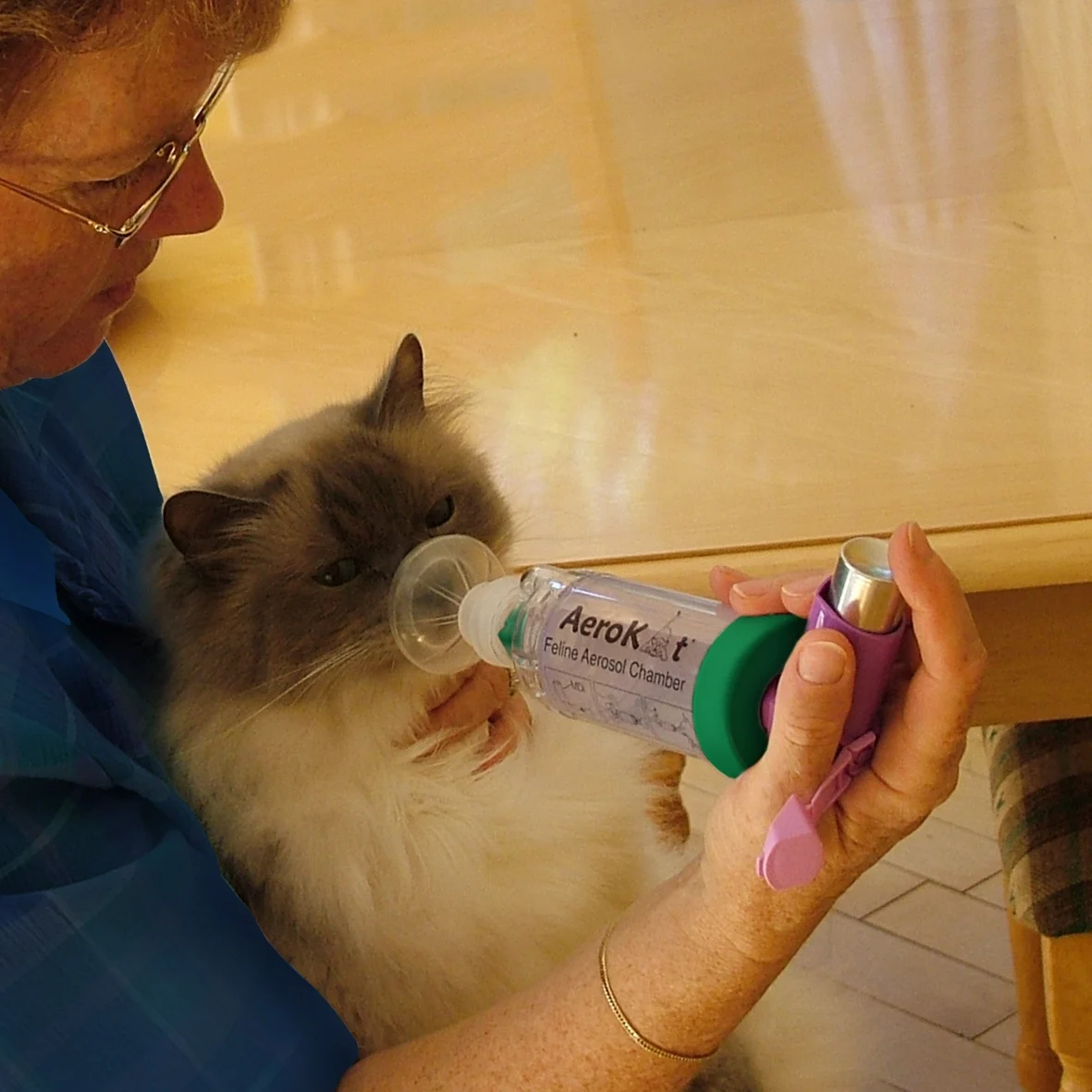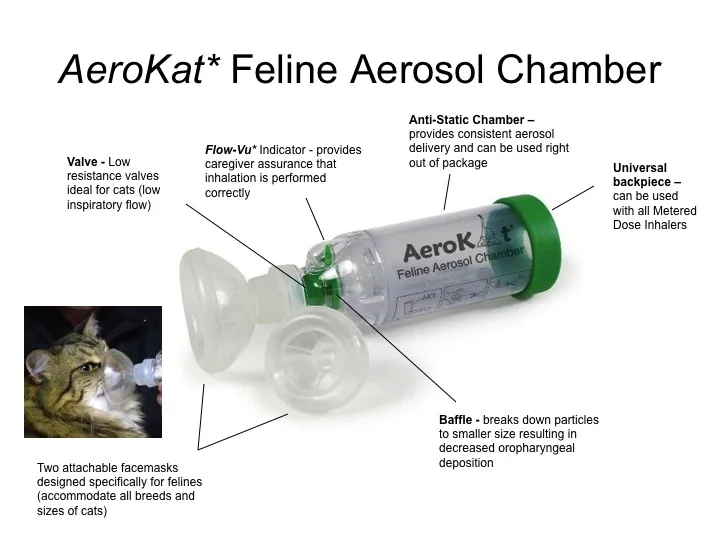Inhaled Corticosteroids & Airway Disease
Elizabeth Rozanski, DVM, DACVECC, DACVIM, Cummings School of Veterinary Medicine at Tufts University

You have asked…
Are inhaled corticosteroids effective for managing chronic inflammatory airway disease?
The expert says…
Airway disease is classified as acute or chronic. Acute airway disease is represented by such conditions as infectious tracheobronchitis, while common chronic airway diseases include canine chronic bronchitis and feline lower airway disease (asthma). It is important to recognize that ongoing therapy is key in achieving successful outcomes in patients with chronic conditions. Conditions such as epilepsy or atopy are controlled, not cured, and chronic airway disease should follow the same treatment paradigm.
To identify the etiology of chronic airway disease, treatable causes of cough and airway inflammation must first be excluded, including Mycoplasma or Bordetella bronchiseptica infection, cardiac disease with left atrial enlargement and progressive compression of mainstem bronchi, laryngeal dysfunction, parasitic disease, presence of airway foreign bodies, or neoplastic disease.
Inflammatory Airway Disease
Glucocorticoids, such as prednisone, are the mainstay of therapy for inflammatory airway disease in small animals. However, oral corticosteroids have significant side effects in dogs, including polyuria/polydipsia, weight gain, behavioral changes, and hepatomegaly. Cats have shown increased tolerance to the side effects of glucocorticoids, but oral glucocorticoid administration has been associated with a greater incidence of diabetes mellitus and repositol products have been associated with congestive heart failure in cats.1
Inhaled corticosteroid (IC) drugs are the first-line treatment for humans with asthma and other inflammatory airway diseases and have been proposed as treatment for moderate to severe steroid-responsive lower airway disease in both dogs and cats.
Inhaled β2-agonists (eg, albuterol) are also widely used for bronchodilation in humans with asthma, although recent studies have demonstrated increased mortality and decreased therapeutic efficacy associated with frequent use.2 Inhaled β2-agonists are warranted for management of asthma and associated bronchoconstriction in small animals, which occurs in some cats with airway disease but typically not in dogs.
Inhaled Glucocorticoids
The primary advantage of ICs is that they avoid or minimize the systemic side effects associated with oral glucocorticoids while targeting therapy to the lungs. In a 2008 study, Cohn and colleagues4 showed that IC drugs suppressed the hypothalamic–pituitary axis of dogs but had limited effects on the immune system. IC drugs do increase the risk for diabetes in humans, but the diabetogenic effects of these medications in cats have not been evaluated to date.
Because voluntary cooperation is lacking in pets, administration of IC drugs requires use of a face mask and spacer (Figure 1). Several models are available, but the AeroKat and AeroDawg chambers (trudellmed.com/animal-health) seem to be widely used (Figure 2).
Most pets require a period of acclimation to accept the mask and treatment. In addition, the owner could be exposed to the aerosolized product, although in clinically insignificant amounts.
Can Inhaled Medications Be Systemically Absorbed?
The canine and feline nasal cavities are more complex than the human nasal cavity, and aerosolized drugs may readily disperse in the nasal passages of small animals rather than being delivered directly to the lungs. In addition, adults and older children are trained to use inhalers to direct the aerosol to the lungs, so very little (if any) is inhaled through the nose.
In a study of 20 cats that received a nebulized radiopharmaceutical agent via face mask, Schulman et al demonstrated that the agent was deposited in the lungs in all cats, although deposition in the stomach was also evident in 75% of the cats. 3 This would suggest that, contrary to popular belief, some inhaled medications may be absorbed systemically.

A Himalayan receives inhaled medications for the treatment of airway disease. Courtesy of Trudell Medical International

Feline AeroKat Aerosol Chamber delivery device. Courtesy of Trudell Medical International
Preparations and Dosing
Several IC preparations are available, including fluticasone, beclomethasone, budesonide, ciclesonide, and mometasone. All IC medications are expensive, and no generic versions are available at this time. Most studies of IC use in small animals have focused on fluticasone.
The optimum dosing of IC drugs in dogs and cats is unknown. One feline study supported a starting fluticasone dose of 44 mcg Q 12 H,5 while another advised 250 mcg Q 24 H.6 Anecdotal recommendations for cats include a dose of 110 mcg Q 12 H (to a maximum 440 mcg Q 12 H).
In dogs, starting IC doses of 110 mcg Q 12 H (for dogs weighing up to 10 kg), 220 mcg Q 12 H (10–25 kg), and 440 mcg Q 12 H (>25 kg) may be considered, although no published dosing information is available to support these recommendations.7 In both dogs and cats, oral glucocorticoid therapy is typically continued for about 10 to 14 days with a tapering overlap.8
IC medications were initially available in metered-dose inhalers (MDI) with propellant chlorofluorocarbons (CFCs), but CFCs have been phased out because of concerns about their effects on the ozone layer. MDIs are now available using other ozone-safe propellants or as dry powder preparations. However, dry powder preparations are not clinically useful in dogs and cats because of the voluntary effort required to utilize them.
Combination products that contain fluticasone and the long-acting β2-agonist salmeterol are available; one recent study demonstrated improved efficacy with the use of this product in an experimental model of feline asthma.9
The Bottom Line
To date, no studies have specifically evaluated the advantages of IC drugs over oral prednisone in dogs or cats with naturally occurring airway disease. However, it is prudent for practitioners to be familiar with inhaled medications.
The advantages of inhaled medications may include fewer systemic effects and complications. It is rare for a cat or dog to respond well to IC drugs if it has not demonstrated clinical improvement with oral steroids. However, if oral steroids are not tolerated or indicated in a particular patient—despite a positive clinical response—transition to IC drugs may be beneficial.
Teaching Pet Owners About IC Use
It is important that veterinary practitioners become familiar with IC drugs so they can readily discuss the pros and cons of their use with clients. The veterinary team should be able to refer clients to helpful resources concerning IC drug use in pets (particularly cats). One of the best online resources for cat owners is “Feline Asthma with Fritz the Brave!” (fritzthebrave.com), which provides guidelines for the management of cats with lower airway disease.